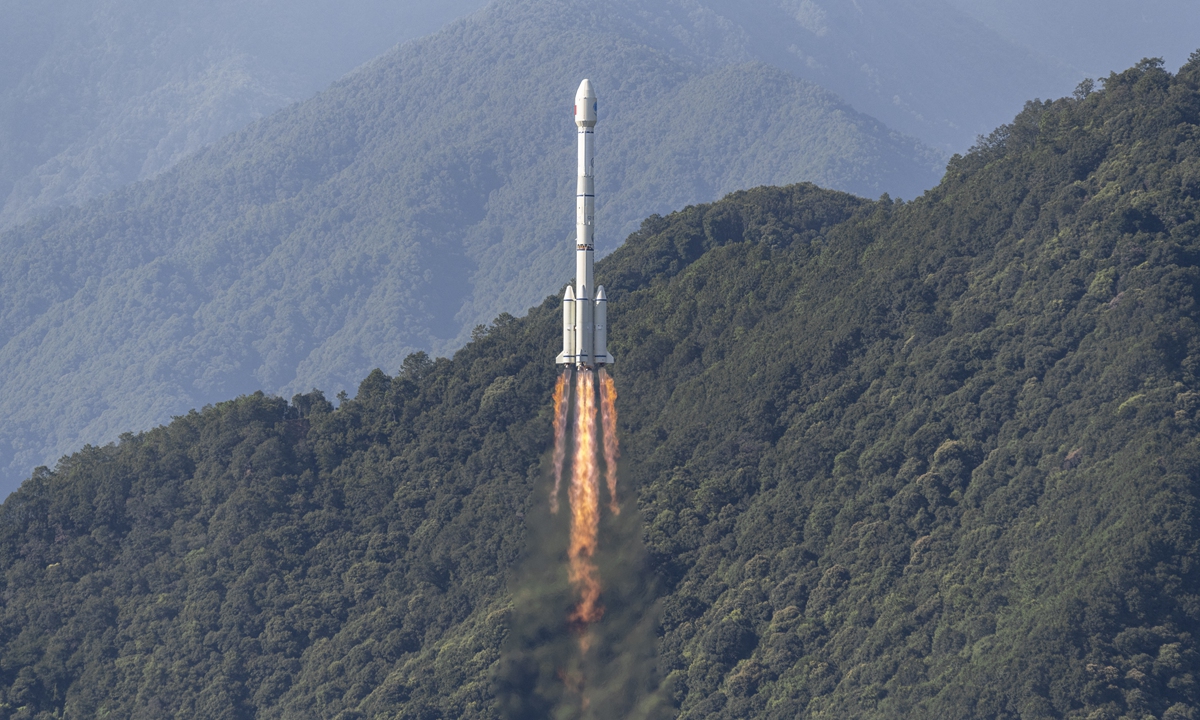
China on Thursday launched two new satellites of the BeiDou-3 Navigation Satellite System (BDS-3) from the Xichang Satellite Launch Center in southwest China's Sichuan Province. The two satellites, the 59th and 60th satellites of the BeiDou system, were launched at 9:14 a.m. (Beijing Time) by a Long March-3B carrier rocket and the Yuanzheng-1 (Expedition-1) upper stage attached to the carrier rocket. Photo: VCG
China on Thursday launched two new satellites of the BeiDou-3 Navigation Satellite System (BDS-3) from the Xichang Satellite Launch Center in Southwest China's Sichuan Province, the final batch of backup satellites for the BDS-3. They are expected to play a crucial role in enhancing the operational stability of the system, industry insiders said.
Next, China is set to enter the deployment phase of BeiDou-4, during which the two satellites will conduct relevant tests to facilitate technological upgrades for the next generation of the BeiDou navigation system in preparation for this new phase.
The BeiDou system, developed independently by China, is one of the four global satellite navigation systems recognized by the UN, with the other three being GPS (the US), GLONASS (Russia), and Galileo (the EU).
In addition to the backup satellites, the BeiDou-3 system currently has a total of 30 operational satellites in orbit, 24 of which are distributed across three orbital planes in Medium Earth Orbit (MEO), three in Geostationary Orbit and three in Inclined Geosynchronous Orbit.
Most satellites have a design lifespan of 10 years, and many of the current operational satellites have been in service for six years. The BeiDou system is considering upgrading and deploying its network satellites, the China Central Television (CCTV) reported.
The latest satellites blasted into space belong to the MEO category. They will be integrated into the navigation system after completing in-orbit testing, China Space News reported on Thursday.
Compared to the earlier MEO satellites, this group has upgraded onboard atomic clock configurations and is equipped with new inter-satellite link terminals. Once operational, they will further enhance the reliability of the BeiDou-3 global satellite navigation system and improve services such as positioning, navigation, timing and global short message communication, the report said.
While enhancing the networking service capabilities of the current BeiDou system, researchers have begun exploring next-generation satellite technologies.
Liu Yingchun, chief designer of the BDS-3, revealed that for the next step, the country will begin the deployment of BeiDou-4, and the two satellites from the last group of BeiDou-3 will conduct technological verification and exploration, serving as a bridge between the past and the future, Liu said.
China will also build a comprehensive positioning, navigation and timing (PNT) system based on the BeiDou system to better serve global users. According to the plan, China aims to establish a more ubiquitous, integrated and intelligent comprehensive PNT by 2035, providing a stronger, safer and more reliable system that covers everything from indoors to outdoors, and from deep sea to deep space, the CCTV report said.
Since its conceptualization in the 1980s and the official launch of BeiDou-1 system in 1994, generations of scientists have devoted their lives to building an independent navigation and communication satellite constellation system. "Despite facing enormous challenges at that time, including the lack of launch capabilities and engineering practices, China remained steadfast in its goal to establish a fully autonomous navigation system - this is why China is able to achieve this feat," Wang Yanan, chief editor of Beijing-based Aerospace Knowledge magazine, told the Global Times on Thursday.




